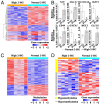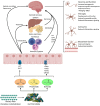Emerging Biomarkers in Metabolomics: Advancements in Precision Health and Disease Diagnosis
- PMID: 39684900
- PMCID: PMC11642057
- DOI: 10.3390/ijms252313190
Emerging Biomarkers in Metabolomics: Advancements in Precision Health and Disease Diagnosis
Abstract
Metabolomics has come to the fore as an efficient tool in the search for biomarkers that are critical for precision health approaches and improved diagnostics. This review will outline recent advances in biomarker discovery based on metabolomics, focusing on metabolomics biomarkers reported in cancer, neurodegenerative disorders, cardiovascular diseases, and metabolic health. In cancer, metabolomics provides evidence for unique oncometabolites that are important for early disease detection and monitoring of treatment responses. Metabolite profiling for conditions such as neurodegenerative and mental health disorders can offer early diagnosis and mechanisms into the disease especially in Alzheimer's and Parkinson's diseases. In addition to these, lipid biomarkers and other metabolites relating to cardiovascular and metabolic disorders are promising for patient stratification and personalized treatment. The gut microbiome and environmental exposure also feature among the influential factors in biomarker discovery because they sculpt individual metabolic profiles, impacting overall health. Further, we discuss technological advances in metabolomics, current clinical applications, and the challenges faced by metabolomics biomarker validation toward precision medicine. Finally, this review discusses future opportunities regarding the integration of metabolomics into routine healthcare to enable preventive and personalized approaches.
Keywords: biomarkers; cancer; diabetes; disease diagnosis; gut-microbiota; metabolomics; neurodegenerative; personalized medicine; precision health.
Conflict of interest statement
The authors declare no conflicts of interest.
Figures





References
Publication types
MeSH terms
Substances
LinkOut - more resources
Full Text Sources

